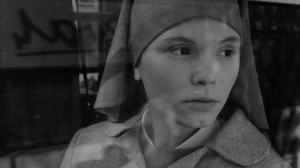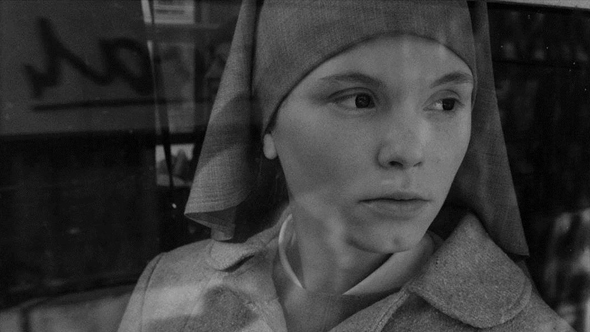 Ida is brought to us by U.K based director Pawel Pawliowski, and set in his native Poland. Filmed in luminous black-and-white, each frame could belong in a photography exhibition, which makes it all rather entrancing and satisfying to behold. It opens in a convent, where Anna (Agata Trzebuchowska), a young woman, is getting prepared to take her vows and commit to a life serving God. Anna is a reserved, serious woman who can’t be older than her late teens. Her red hair is hidden through the monochrome on the one occasion she chooses to let it fall down. Her eyes are wide and look black, she is delicately thin and rarely smiles, making her appear a ghostly figure. Brought the convent as a small orphan child, she has been raised by nuns, and has been told by her Mother Superior to seek out her last surviving relative before she takes the veil. The relative in question is her aunt, a middle-aged promiscuous intellectual judge named Wanda (Agata Kulesza) who has previously ignored her existence, a woman who drink drives, chain smokes and looses herself in the abyss of sex and drugs in an attempt to numb herself. Pawliowski clearly has an interest in the psychological repercussions of devoting oneself to religion, as also explored in previous work My Summer of Love, that exists in his archive with Last Resort and Woman in the Fifth.
Ida is brought to us by U.K based director Pawel Pawliowski, and set in his native Poland. Filmed in luminous black-and-white, each frame could belong in a photography exhibition, which makes it all rather entrancing and satisfying to behold. It opens in a convent, where Anna (Agata Trzebuchowska), a young woman, is getting prepared to take her vows and commit to a life serving God. Anna is a reserved, serious woman who can’t be older than her late teens. Her red hair is hidden through the monochrome on the one occasion she chooses to let it fall down. Her eyes are wide and look black, she is delicately thin and rarely smiles, making her appear a ghostly figure. Brought the convent as a small orphan child, she has been raised by nuns, and has been told by her Mother Superior to seek out her last surviving relative before she takes the veil. The relative in question is her aunt, a middle-aged promiscuous intellectual judge named Wanda (Agata Kulesza) who has previously ignored her existence, a woman who drink drives, chain smokes and looses herself in the abyss of sex and drugs in an attempt to numb herself. Pawliowski clearly has an interest in the psychological repercussions of devoting oneself to religion, as also explored in previous work My Summer of Love, that exists in his archive with Last Resort and Woman in the Fifth.
Anna arrives and Wanda receives her at first with an unflinching coldness, informing her that she is Jewish and her real name is Ida Lebernsten. Ida wishes to visit the graves of her newly discovered relatives, but they have none, having been killed and placed in an unidentifiable location. Together, the pair visit the bleak country farmhouse of the family who kept her parents in hiding during the war, and see what they can discover. Three weeks in they develop a subtle, understated closeness and face up to the saddening truth, whilst Ida experiences lust and begins to have doubts about her chosen path. Pawliowski is working on observations surroundings and visuals, expressing the film through place, atmosphere and facial expressions rather than dialogue. The characters are well drawn nonetheless. The most striking feature of Ida though, is the way the shots are composed. Light is a vivid presence, each frame has been exquisitely rendered to draw the eye to the light within it whether it be from a table lamp, a ceiling light in a bar, or the sun. This works with the monochrome to create a consistently eery, ethereal effect. Often it is delicately resting on the right-hand side of whoever has their face is in the frame. In one scene, with a backdrop of dismal and dreary weather in a communist-era deprived village, the sun in the sky could easily be the moon in the evening. Equally vivid is the opt for a classic 1960s box-like Academy format, in severe contrast with most of today’s films in 1.37 aspect ratio. A stunning art film.
This review comes from a screening at the 57th BFI London Film Festival 2013 (LFF 2013).




